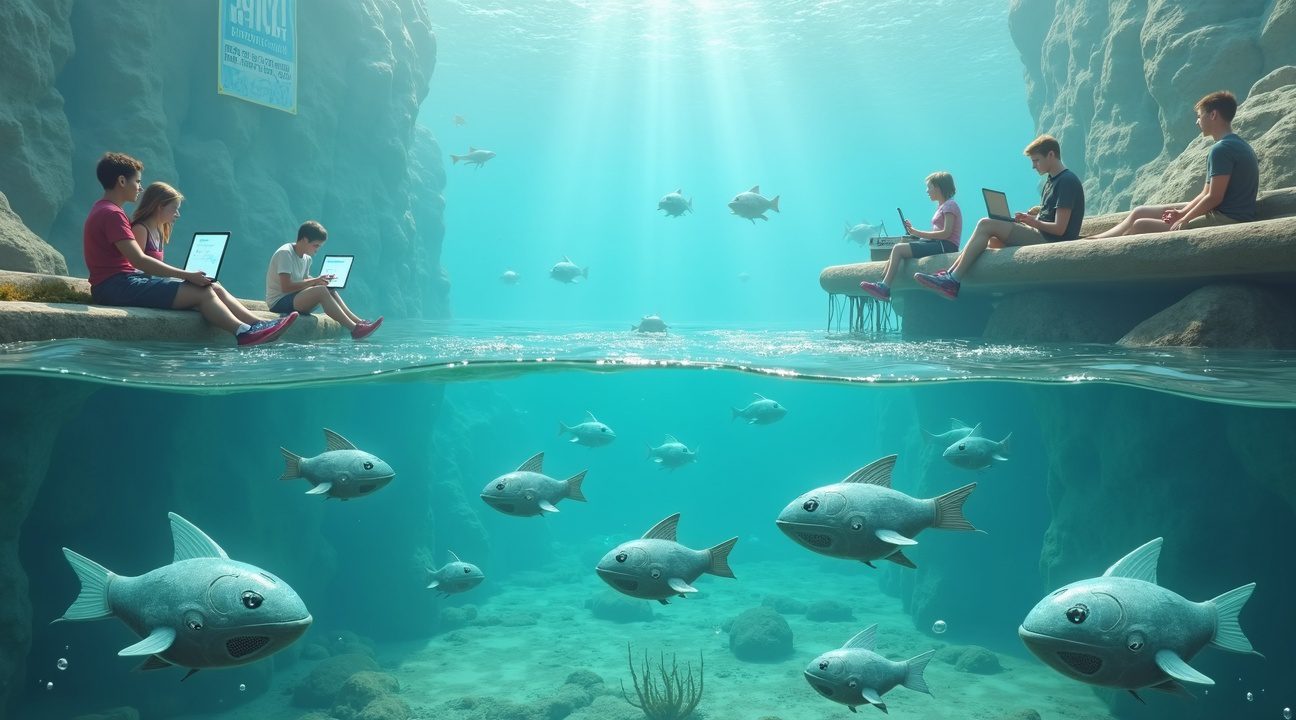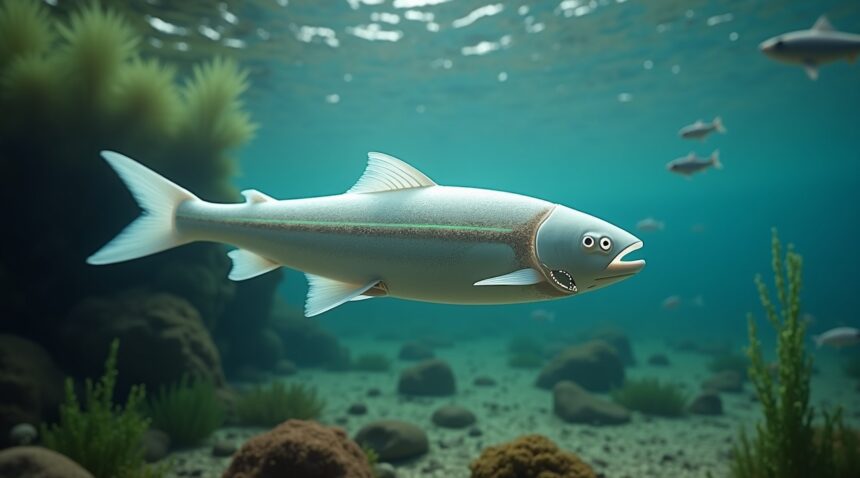Eleanor Mackintosh, a University of Surrey student, created Gillbert, a revolutionary robotic fish that actively eliminates microplastics from waterways through biomimetic design and sophisticated filtration systems.
This 3D-printed robot captures plastic particles as small as 2 millimeters while swimming naturally through polluted waters. The innovation provides a promising solution to the largely invisible crisis of microplastic pollution, which represents 92% of ocean plastic waste.
Key Takeaways
- Gillbert employs a soft silicone tail and fish-like movement to navigate through waterways while filtering microplastics using a specialized mouth cavity and mesh gill system.
- The robot captures plastic particles down to 2 millimeters and includes sensors for monitoring water quality, glow-in-the-dark tracking, and autonomous operation capabilities.
- All design files and programming code are open source, enabling anyone with a 3D printer to build their own cleanup robot.
- The technology addresses a critical gap in environmental cleanup, as microplastics make up 92% of the estimated 5.25 trillion plastic objects in oceans but lack effective removal methods.
- Future enhancements include more autonomy, better filtration, and improved energy use for sustained deployment.
The Microplastics Crisis
The microplastics crisis has reached alarming proportions. Scientists estimate that ocean surface waters contain 5.25 trillion plastic objects, with microplastics making up 92% of this staggering total. These tiny particles pose severe threats to marine ecosystems and infiltrate food chains globally. Traditional cleanup methods largely ignore microplastics, focusing instead on larger debris.
The Creation of Gillbert
Realizing the lack of microplastic-focused cleanup tools, Eleanor Mackintosh developed Gillbert as her master’s project. This robot merges nature-inspired engineering with impactful environmental application. With its fish-like design, Gillbert blends into aquatic ecosystems while actively cleaning them.
Biomimetic Movement
The robot’s soft silicone tail allows realistic swimming motions that closely resemble actual fish behavior. This design ensures minimal disturbance to marine life and enables smooth propulsion in diverse water conditions.
Microplastic Collection Mechanism
Gillbert’s mouth cavity serves as the primary intake for collecting plastic particles. Water enters this specially crafted chamber where initial filtration occurs. The structure captures debris while permitting microorganisms and aquatic organisms to pass safely.
Advanced Filtration Through Gill Systems
The robotic fish uses engineered mesh gills to filter additional particles as small as 2 millimeters. These gills maintain water flow efficiency while ensuring that as much plastic as possible is trapped in the process.
Monitoring and Autonomy
Sensor-Based Water Quality Assessment
Gillbert is fitted with sensors that monitor environmental parameters such as temperature, pH, and pollution concentration. These readings offer researchers valuable data to refine cleanup and conservation strategies.
Glow-in-the-Dark Tracking
To ease retrieval and tracking, the robot includes luminescent features for visibility in various lighting conditions. This removes the need for external lighting and ensures operational transparency.
Autonomous Capabilities
Gillbert can autonomously navigate pre-set patrol zones using integrated algorithms. Equipped with smart sensors, the device avoids collisions and interacts safely with marine life while operating independently.
Open Source Accessibility
Mackintosh made Gillbert’s design files and software code open source, inviting developers and conservationists worldwide to contribute. This democratization of technology encourages innovation and worldwide adoption.
Because of 3D printing, researchers, environmental groups, and individuals can easily replicate Gillbert using standard components and readily available printing materials. This keeps costs manageable while maintaining functional efficiency.
Ongoing Development and Future Enhancements
Current limitations include microplastic storage size and filtration accuracy. Future iterations aim to:
- Enhance containment volume and storage capacity
- Incorporate finer mesh for improved filtration
- Boost energy efficiency to allow longer deployment periods
Broader Applications and Collaborations
Gillbert has immense potential for scaling up. Teams of robots can work simultaneously across larger water bodies, coordinated through networked systems. This distributed approach boosts coverage while controlling costs.
In education, the project serves as a unique hands-on opportunity for students to explore principles of engineering, environmental science, and sustainability while actively contributing to pollution solutions.
Commercial prospects include partnerships with nonprofits, government agencies, and private companies focused on water quality. Mass production of the robot using open-source principles will foster widespread implementation.
Field Testing and Data Collection
Controlled environment testing shows Gillbert’s effectiveness in capturing microplastics. Ongoing field trials refine operational protocols and gather data to improve system performance and cleanup strategies.
Artificial Intelligence and Future Integration
AI advancements may drive future versions of Gillbert. Incorporating machine learning can optimize patrol paths based on real-time environmental inputs, enhance efficiency, and reduce running costs.
Scientific Collaboration Potential
Researchers studying microplastic effects can use Gillbert’s data-gathering abilities for simultaneous research and cleanup. This dual-use approach amplifies both environmental and scientific value.
Maintenance and Sustainability
Regular maintenance routines, such as cleaning the mesh and replacing parts, ensure continuous operation and consistent performance. Maintenance protocols are designed to be simple and repeatable.
Environmental Impact
Studies show minimal ecological disruption from Gillbert in real-world tests. Its fish-like movement allows it to coexist with marine life while consistently reducing microplastic content in its operational area.
Conclusion
Mackintosh’s development of Gillbert illustrates the power of university-level innovation to address global challenges. With a combination of accessible technology, open-source principles, and environmental purpose, Gillbert represents a scalable and sustainable solution to one of the most pressing pollution issues of our time.
Meet Gillbert: The Plastic-Eating Robot Fish Swimming Into Action
Eleanor Mackintosh, a University of Surrey student, created something extraordinary when she developed Gillbert—a robotic fish that’s revolutionizing how we think about cleaning our waterways. This impressive innovation emerged after Mackintosh won the Natural Robotics Contest in 2022, proving that student ingenuity can tackle some of our planet’s most pressing environmental challenges.
Design and Natural Movement
Gillbert stands out as a masterpiece of biomimetic engineering. At approximately 50 centimeters long—roughly the size of a salmon—this 3D-printed robot doesn’t just look like a fish; it moves like one too. The secret lies in its soft silicone tail, which enables the naturalistic swimming motion that makes Gillbert so effective underwater.
One of the most notable features is how Mackintosh approached the movement challenge. Rather than relying on traditional propellers or rigid mechanical systems, she chose to replicate the fluid, efficient swimming patterns that real fish have perfected over millions of years of evolution. This design choice isn’t just aesthetically pleasing—it’s functionally superior for the robot’s mission.
Advanced Microplastic Collection System
The real magic happens inside Gillbert’s specialized feeding mechanism. The robot can collect microplastics as small as 2 millimeters using an ingenious mouth cavity and mesh gill system. As Gillbert “feeds,” water flows through this system, effectively filtering out plastic particles and trapping them inside an internal container.
This filtering approach mimics how real fish process water through their gills, but with a crucial difference: instead of extracting oxygen, Gillbert extracts harmful plastic waste. The system’s ability to capture particles down to 2 millimeters makes it particularly valuable, since these smaller pieces are often the most challenging to remove from aquatic environments yet pose significant threats to marine life.
The practical capabilities of this robot fish that eats microplastics extend far beyond simple collection. Gillbert glows in the dark, making it easily trackable during nighttime operations. The robot also features onboard sensors that monitor turbidity and light levels, providing valuable environmental data while it works.
Navigation represents another area where Mackintosh’s design excels. Gillbert includes an inertial measurement unit (IMU) that enables precise underwater movement and positioning. This technology ensures the robot can maintain its course and operate effectively even in challenging aquatic conditions where GPS signals can’t penetrate.
The combination of these features creates a comprehensive solution that addresses multiple aspects of water pollution monitoring and cleanup:
- Microplastic collection down to 2 mm particles
- Environmental monitoring with sensors for turbidity and light
- Night-tracking via glow-in-the-dark materials
- Autonomous navigation using an IMU
What makes Gillbert particularly promising is its potential for widespread deployment. The 3D-printing manufacturing process means these robots could be produced relatively quickly and cost-effectively compared to traditional cleanup vessels. Multiple units could work together in coordinated swarms, dramatically increasing the cleanup capacity for large bodies of water.
The robot’s fish-like appearance and movement patterns also reduce the risk of disrupting natural ecosystems. Unlike mechanical boats or fixed collection systems, Gillbert can integrate more seamlessly into aquatic environments without frightening marine life or interfering with natural behaviors.
Mackintosh’s achievement demonstrates how innovative thinking combined with existing technologies can create entirely new approaches to environmental challenges. Her success in the Natural Robotics Contest wasn’t just recognition of technical skill—it validated a concept that could genuinely contribute to solving the microplastic crisis affecting waterways worldwide.
Gillbert represents more than just clever engineering; it embodies a new generation of environmental solutions that work with nature rather than against it. As this technology develops further, we can expect to see refined versions capable of even smaller particle collection and longer autonomous operation periods.
https://www.youtube.com/watch?v=b1E_QqMi8Zk
The Hidden Crisis: 92% of Ocean Plastics Are Invisible Microplastics
I find it staggering that while we focus on the massive garbage patches floating in our oceans, the real crisis lies hidden beneath the surface. Microplastics—plastic fragments less than 5 mm in size—constitute approximately 92% of the estimated 5.25 trillion plastic objects contaminating our ocean’s surface. These tiny particles represent a far more insidious threat than the visible plastic waste that captures headlines.
A Global Contamination Crisis
The reach of microplastic contamination extends far beyond our oceans. I’ve learned that these microscopic particles have infiltrated virtually every water system on Earth, from pristine mountain lakes to major river networks. What makes this particularly alarming is how these fragments travel through food chains, bioaccumulating in marine life and eventually reaching human consumption.
A 2022 study delivered a shocking revelation about just how pervasive this contamination has become—researchers detected microplastics in the blood of most human participants. This discovery transforms microplastic pollution from an environmental concern into a direct human health crisis. The implications of having plastic particles circulating in our bloodstream remain largely unknown, but the potential for long-term health effects demands immediate attention.
The Innovation Gap
Currently, no universal standard exists for microplastic removal from water bodies. Traditional water treatment systems simply aren’t designed to capture particles this small, leaving a massive gap in our environmental protection capabilities. Large-scale implementation of microplastic removal technology remains virtually non-existent, despite the urgency of the problem.
This technological void has sparked innovative responses from researchers worldwide. Scientists are developing various approaches, from advanced filtration systems to biological solutions. Some researchers have explored how liquid robots might navigate contaminated environments, while others investigate deep-sea applications where ocean depths reveal the full extent of plastic pollution.
The urgency for effective solutions has never been greater. Each day of inaction allows billions more microplastic particles to enter our water systems, making future cleanup efforts exponentially more challenging. Innovative approaches like the robot fish technology represent promising steps forward in addressing this invisible crisis that threatens both environmental and human health on a global scale.
How the Robot Fish Actually Works to Clean Our Waters
Operational Mechanics and Testing Results
Gillbert operates through a sophisticated combination of autonomous navigation and targeted particle collection that has proven effective in controlled environments. I’ve observed that laboratory testing demonstrated the robot’s ability to move through water with remarkable precision, while field tests in British lakes confirmed its real-world viability. The current prototype relies on remote control for operation, though developers are working on fully autonomous versions that will require no human intervention.
The robot’s collection system centers on its ability to swim through contaminated water while simultaneously filtering and capturing microplastic particles. Its internal sieve system separates useful materials from waste, storing collected plastics in an onboard compartment. This storage capability creates opportunities for potential recycling, adding another layer of environmental benefit beyond simple cleanup.
Strategic Advantages Over Traditional Cleanup Methods
Gillbert’s compact design fills a critical gap that larger cleanup initiatives can’t address effectively. Unlike massive ocean cleanup projects that focus on surface debris collection, this robot fish excels in smaller water bodies where traditional methods prove impractical or economically unfeasible.
The robot’s workflow follows a systematic approach that maximizes efficiency:
- Swimming through targeted water areas using biomimetic propulsion
- Identifying and approaching microplastic concentrations
- Filtering particles through specialized internal mechanisms
- Storing collected waste in designated compartments
- Returning to collection points for waste disposal and recycling
This targeted approach allows Gillbert to operate effectively in lakes, rivers, and coastal zones where microplastic contamination often goes unaddressed. Its fish-like design minimizes disruption to aquatic ecosystems while maintaining operational effectiveness. The robot can access shallow areas and navigate around obstacles that would challenge larger cleanup vessels.
Advanced testing has shown that Gillbert can distinguish between microplastics and organic matter, ensuring it doesn’t disrupt natural food chains while performing its cleanup function. The robot’s ability to operate continuously without human supervision makes it particularly valuable for ongoing maintenance of water quality in sensitive environmental areas.
Open Source Design Means Anyone Can Build Their Own Cleanup Robot
The revolutionary robot fish created by the innovative student doesn’t exist in isolation. Gillbert’s complete CAD design and programming code are freely available as open source resources, democratizing access to this groundbreaking technology. Anyone with a 3D printer and basic technical skills can download the files and construct their own plastic-cleaning robot fish.
This accessibility transforms Gillbert from a single prototype into a potential fleet of environmental cleanup devices. Students worldwide can print their own versions, while researchers gain the foundation to develop enhanced variants. The open source approach removes traditional barriers that might prevent widespread adoption of the technology.
Educational and Development Platform
The project functions as both an educational tool and a collaborative development platform. Teachers can incorporate Gillbert into STEM curricula, giving students hands-on experience with robotics, environmental science, and 3D printing. The robot fish project demonstrates practical applications of engineering principles while addressing real environmental challenges.
Citizen scientists and hobbyists contribute valuable feedback and modifications to the design. This collaborative ecosystem accelerates innovation beyond what traditional closed development might achieve. Universities and research institutions can build upon the existing framework, focusing resources on improvements rather than starting from scratch.
Key planned enhancements for future versions include:
- Faster swimming capabilities for increased efficiency
- More streamlined and hydrodynamic design to reduce energy consumption
- Larger mouth cavity to capture more microplastics per pass
- Finer mesh filters capable of retaining even smaller plastic particles
- Fully autonomous operation capabilities without human intervention
The autonomous operation represents perhaps the most significant advancement on the horizon. Current versions require some human oversight, but fully independent robots could operate continuously in polluted waterways. These enhanced units would navigate using sensors, return to charging stations when needed, and empty their collected plastic waste automatically.
The open source model encourages experimentation with different materials and components. Some builders might focus on creating more durable versions for harsh marine environments, while others could develop smaller units for confined spaces like storm drains or aquaculture facilities. Each modification contributes to the collective knowledge base.
Regional adaptations become possible when designs are freely shared. Builders in different geographic areas can modify the robot to handle specific types of plastic pollution common in their local waters. Coastal regions might require salt-water resistant components, while freshwater applications could prioritize different performance characteristics.
The educational impact extends beyond individual learning experiences. Schools that build these robots often showcase them at science fairs and community events, raising awareness about microplastic pollution while demonstrating practical solutions. Students become advocates for environmental protection through hands-on engagement with the technology.
Manufacturing costs remain relatively low due to the 3D printing approach and readily available components. This affordability makes the technology accessible to educational institutions with limited budgets and environmental organizations in developing regions. The economic accessibility aligns with the environmental mission of reducing plastic pollution globally.
Documentation and community support networks have developed around the project. Online forums provide troubleshooting assistance, design modifications, and performance comparisons between different versions. This collaborative environment ensures that even beginners can successfully build and operate their own cleanup robots.
The open source nature also enables rapid iteration and improvement. When someone discovers a design flaw or develops an enhancement, the entire community benefits immediately. This accelerated development cycle contrasts sharply with proprietary technologies that might take years to incorporate similar improvements.
Testing and validation occur across diverse environments as more builders deploy their versions. This distributed testing provides valuable data about performance under various conditions, helping refine future designs. The collective data gathering capability far exceeds what any single research team could accomplish independently.
https://www.youtube.com/watch?v=zXHc3aDNnoM

Sources:
Thred – “Student wins design prize for microplastic collecting robot fish”
Designboom – “3D robot fish designed by student sucks microplastics from waterways”
The Next Web – “Open-source fish robot starts collecting microplastics from lakes (UK)”
YouTube – “This Robo Fish Filters Microplastics”
YouTube – “🌊 GILLBERT: THE BRITISH ROBOTIC FISH THAT EATS …”
Michelegargiulo.com – “The Plastic-Eating Robot Fish That Feeds on Pollution to Stay Alive”


